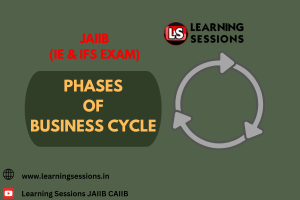The Phases of the Business Cycle are constitutional to understand the variations in economic activity, which directly impact the financial system. For banking professionals pursuing the JAIIB certification, an in-depth knowledge of these phases is critical. The business cycle not only affects macroeconomic factors such as GDP growth and inflation but also the operations of banks, the flow of credit, and the overall health of the Indian financial system.

📚 JAIIB Study Resources 📚
👉 Check Here
👉 Check Here
👉 Check Here
👉 Get Tests Here
👉 Check Here
DOWNLOAD PDF PHASES OF BUSINESS CYCLE -CASE STUDY
This article delves into the phases of the business cycle, particularly from the perspective of the Indian economy, to provide insights on how banks, policymakers, and financial institutions manage these phases. Understanding these cycles enables financial professionals to make informed decisions regarding risk management, lending, and investment. For the extensive preparation of candidates, get details through our YouTube videos for JAIIB IE & IFS Module wise Syllabus with explanations and tips to help candidates in their preparation journey.
You may also like these JAIIB Case Studies:
JAIIB | IE & IFS | BANKING STRUCTURE IN INDIA
JAIIB | IE & IFS | SIDBI
The business cycle consists of four key phases: Boom, Recession, Depression and Recovery. Each phase has distinct characteristics that influence the economy and the financial system in different ways. Let’s break down these phases in the context of the Indian economy.
- Boom: A period of rapid economic growth, high demand, rising employment, and increasing consumer confidence.
- Recession: A slowdown in economic activity marked by declining GDP, rising unemployment, and reduced consumer spending.
- Depression: A prolonged and severe downturn in the economy with significant declines in GDP, high unemployment, and widespread business failures.
- Recovery: The phase where economic activity begins to rise after a recession or depression, with improving GDP, employment, and business conditions.
Overall it may be said, to be aware of the phases of the business cycle is critical for banking professionals studying for the JAIIB exam, as it helps in anticipating changes in credit demand, risk management, and financial stability. For banks, effectively navigating these phases requires close monitoring of macroeconomic indicators, cautious lending practices, and maintaining adequate capital reserves to withstand economic downturns. Policymakers, particularly the RBI, play a major role in stabilizing the financial system through monetary policies designed to manage inflation, credit supply, and liquidity during various phases of the business cycle. Learning Sessions provides additional information about JAIIB IE & IFS EXIM BANK by giving examples of real life scenarios.
Learn more about this case study through our YouTube channel and PDF.
Get access to our Telegram Channel for free Pdfs of JAIIB.







